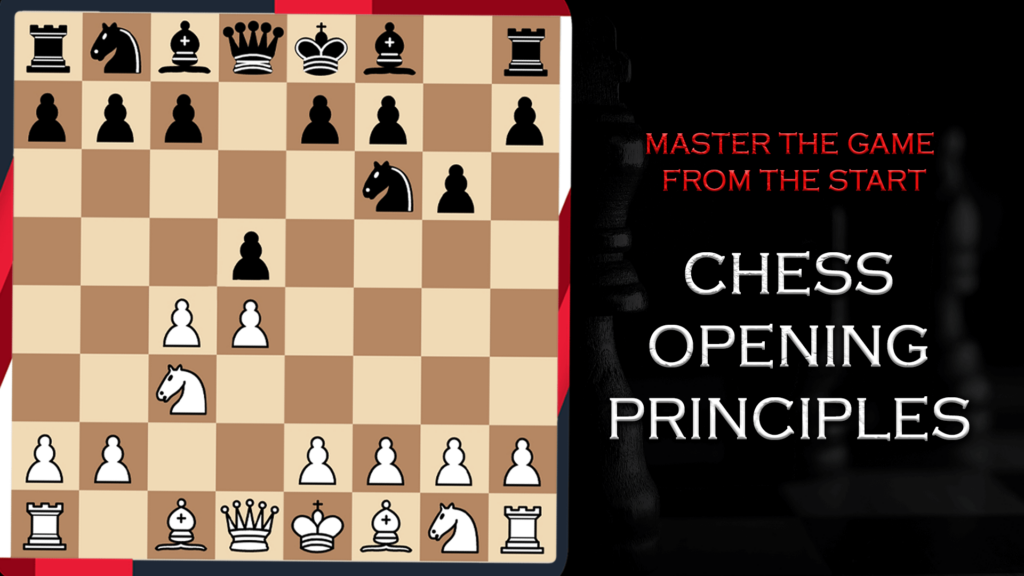Chess Opening Principles
May 26, 2023
In the fascinating world of chess, mastering the opening moves can make all the difference in determining the outcome of a game. Every chess player knows that the opening phase sets the stage for the entire match, influencing strategic decisions, piece development, and overall control of the board. Whether you are a beginner or an experienced player looking to enhance your skills, understanding the fundamental principles of chess openings is crucial. In this comprehensive guide, we will delve into the key concepts and strategies that will help you navigate the intricacies of chess openings, empowering you to outwit your opponents and seize victory.

1. The Importance of Chess Opening Principles
The chess opening is the initial phase of the game, where players establish their positions and set the groundwork for future moves. Understanding and applying opening principles is essential for several reasons:
1.1. Development: The opening phase is primarily concerned with piece development. By following opening principles, you can efficiently mobilize your forces and gain control over the center of the board, allowing for greater flexibility and potential attacking opportunities.
1.2. Control: A solid opening ensures that you have a firm grip on crucial squares and diagonals, denying your opponent easy access and limiting their options. It also helps establish a harmonious coordination among your pieces, enabling a smooth transition into the middle game.
1.3. Strategy: The opening choices you make can reflect your strategic intentions. Different openings emphasize various concepts, such as pawn structure, piece activity, or king safety. By understanding the underlying ideas behind each opening, you can align your strategy with your preferred style of play.
2. Fundamental Opening Principles
To excel in the opening phase, it is vital to adhere to the following fundamental principles:
2.1. Occupy the Center: The center of the chessboard holds significant importance as it provides better mobility and control over key squares. Aim to occupy the central squares with your pawns and pieces, establishing a solid foundation for future maneuvers.
2.2. Develop Pieces: Rapid piece development is crucial in the opening. Bring your knights and bishops out to active squares, preferably towards the center, allowing them to exert influence and support future initiatives.
2.3. Pawn Structure: Be mindful of your pawn structure during the opening. Avoid creating weaknesses or leaving vulnerable points that your opponent can exploit. Maintain a balanced pawn formation that provides a solid base for your position.
2.4. King Safety: Castling early in the game is a prudent move, ensuring the safety of your king. Securing your monarch behind a protective pawn shield while activating your rooks helps in connecting and harmonizing your forces.
2.5. Coordination: Strive for harmonious coordination among your pieces. Avoid moving the same piece multiple times or neglecting the development of specific pieces. Seek to establish connections and cooperation among your forces for greater effectiveness.
3. Common Chess Openings
There are numerous chess openings, each with its unique characteristics and strategic ideas. Let’s explore a few popular ones:
3.1. The Ruy Lopez: This opening aims to control the center and establish a solid foundation for future plans. It involves developing the bishop to b5, putting pressure on Black’s knight and preparing to double the rooks on the e-file.
3.2. The Sicilian Defense: This aggressive opening is a favorite among many players seeking to challenge White’s central control. By playing …d6 and …Nf6, Black prepares to strike back at the center and create imbalances.
3.3. The Queen’s Gambit: This opening focuses on central control and pawn structure. White offers a pawn to gain control over the center and initiate active piece development, while Black can choose to accept or decline the gambit.
3.4. The King’s Indian Defense: Black adopts a hypermodern approach, allowing White to occupy the center initially and then counter-attacks later in the game. It emphasizes piece activity and attacking chances on the king’s side.
4. Study, Practice, and Improve
Improving your understanding of chess openings requires continuous study and practice. Here are some valuable tips to enhance your opening repertoire:
4.1. Study Opening Theory: Delve into the wealth of available resources, such as books, online courses, and analysis databases. Analyze grandmaster games and study annotated variations to grasp the strategic ideas and tactical nuances of different openings.
4.2. Play Regularly: Engage in practice games, both online and over-the-board, to apply your knowledge and gain practical experience. Experiment with various openings to explore their strengths and weaknesses firsthand.
4.3. Analyze Your Games: After each game, take the time to review and analyze your moves. Identify any weaknesses or mistakes in your opening play and seek to rectify them. Learn from your defeats and capitalize on your victories.
4.4. Seek Guidance: Consider working with a chess coach or joining a chess club to receive expert guidance and feedback. They can provide personalized advice, offer valuable insights, and help you refine your opening repertoire
By mastering chess opening principles and consistently refining your skills, you can gain a significant edge over your opponents. Remember, practice and dedication are key to achieving proficiency in the vast world of chess.
